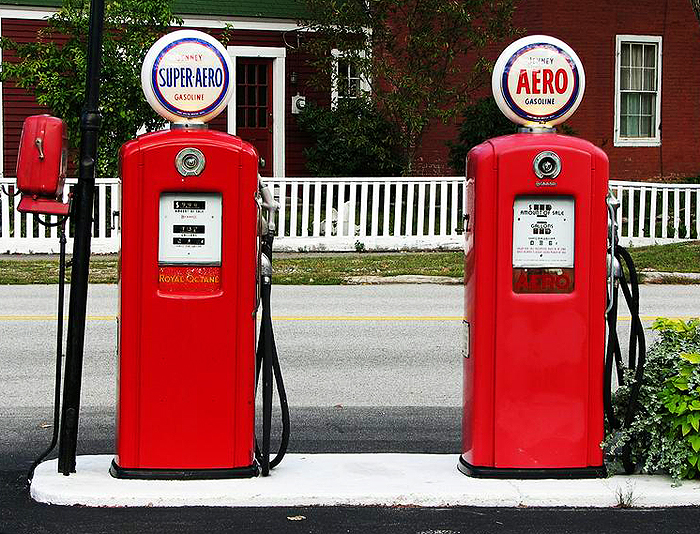After the Clean Air Act of 1995, gasolines do not have as many detergent additives as they used to. This leaves engines more susceptible than ever to carbon and sludge buildup if too low an octane fuel is used. Gasoline costs a great deal of money these days – so make what you purchase at the pump work for you, not against you. Some important things about gasoline…
1. OCTANE RATING – WHAT IT IS AND WHAT YOUR CAR REQUIRES
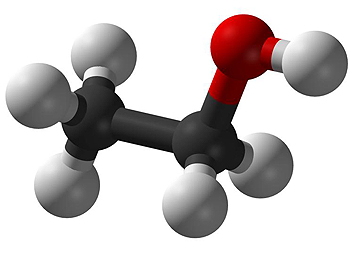
A 3-dimensional illustration of an octane molecule. By definition, octane is a hydrocarbon of the methane series coined from octo- (from okto “eight;”) + -ane, as in methane; so called because it has eight carbon atoms. When added to gasoline, octane molecules allow gasoline to reach a higher temperature and pressure before detonating. (Photo credit: Wikipedia.org)
We all know higher octane gas costs a bit more. But why? The higher the octane number, the more a fuel can be compressed before detonating. In short, fuels with a higher octane rating are needed in higher compression engines that generate high horsepower for their size.
For example, Mercedes-Benz and other German carmakers recommend 91 octane fuel in almost all newer vehicles. Porsche owner manuals specify 93 octane gas. In the words of a Porsche spokesperson on the decree, “It does not indicate any exceptions.” Because 91 or higher octane gas can’t be found sometimes, Mercedes’ advice is to use regular in a pinch — but no more than half a tank — until locating a station that sells premium. Good advice.
2. THE FULL EFFECTS OF USING LOWER OCTANE GAS THAN RECOMMENDED BY THE MANUFACTURER
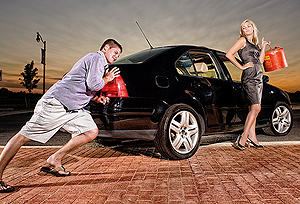
On newer cars, using lower octane gas than the car is tuned for will result in fewer miles per tankful than you expect. (Photo credit: My English Club)
First, fuels with higher octane content are more stable, and resist premature detonation of fuel when it first enters the combustion chamber. If fuel octane measurement isn’t high enough for your vehicle’s engine pressure, that premature detonation causes harmful “knocking” of pistons, connecting rods, and intake/exhaust valve parts. Furthermore, more fuel is left unburned at the end of the combustion stroke which causes a number of ill effects.
Most newer cars have knock sensors that when alerted, signal the car’s engine computer to adjust engine timing so lower combustion pressures result. The end effect is sluggish performance and noticeably lower fuel economy. Any monetary gains that come from buying low octane gas are fully offset by the reduced mileage.

After the Clean Air Act of 1995, gasolines do not have as many detergent additives as they used to. This makes engines more susceptible than ever to carbon and sludge buildup if too low an octane fuel is used. Although this photo of a BMW cylinder head shows an extreme case, I regularly see carbon buildup in the shop causing engine misfires and check engine lights. (Photo credit: M. Klein)
Second, in the shop I regularly see check engine lights that will not stay off due to multiple misfires (often too slight to notice) resulting from carbon and sludge buildup on fuel injectors, intake manifolds, pistons, and cylinder walls. The fix for this is labor intensive – a technician must disassemble the top part of the engine and literally scrub the carbon off engine parts for the car to run right. Unless resulting from another specific problem, this is caused by unburned/low quality fuel 19 times out of 20.
Third, increased amounts of unburned gas going out the exhaust system will, over time, foul oxygen sensors and the catalytic converter(s) your exhaust pipes are equipped with. Catalytic converters are very expensive. In my experience, if an engine is kept in good running condition and good quality gas is always used, there’s no reason a catalytic converter shouldn’t last well over 100,000 miles if not the life of the car.
3. ETHANOL “E10” FUEL ADDITIVE – BOTH A PLUS AND A MINUS
In the EPA’s quest for cleaner air, it mandated in 1992 that reformulated gasoline with 10% additive content be sold during winter months to reduce ground level smog and ozone. Because the methyl tert-butyl ether oxygenate mixed into the gasoline (MTBE) contaminated groundwater significantly when underground storage tanks leaked, this additive was banned and “oxygenated gas” passed into history.
Replacing MTBE as a fuel additive was ethanol, also known as “E10” for the 10% maximum content of it allowed by law. Essentially grain alchohol, it does not have negative environmental effects. However, it is a possible source of grief in your engine.
E10 reduces fuel mileage by 4 to 5% due to its lower b.t.u. heat output per gallon (84,000 vs. 115,000 for gasoline). Mainly, increased amounts of ethanol in standard combustion engines cause incomplete combustion and the ills that result from it.
Many gas stations illegally water down their gasoline with more ethanol than the law allows to stretch profits. Those that are on the level often don’t check the ethanol levels in their tanks, and can just as easily receive a poorly-mixed batch of gasoline from an incompetent or unethical refiner.
I know this happens for a fact. In the shop when a customer’s German car is running poorly and no specific problems can be found, we use a test kit to determine the percent of ethanol in the car’s gasoline. Usually test results show ethanol levels in the sick car between 15% to 20% – much higher than the 10% allowed by law.
Of note: a government-funded study by Mercury Marine Company showed a blend of 15 percent ethanol and gasoline caused such extensive damage to boat engines that the test was ended early.
4. “TOP-TIER” GAS BRANDS
Since minimum gasoline additive performance standards were first established by the EPA Clean Air Act of 1995, most gasoline marketers have since reduced the concentration level of detergent additives by as much as 50%. This has made it tougher for engines to run clean and maintain stringent Tier 2 emission standards.
BMW, General Motors, Honda, Toyota and Volkswagen/Audi have all recognized that the current EPA minimum detergent requirements don’t cut it on today’s higher compression engines. As a result, an unofficial industry standard of rating the highest quality of fuel as “Top Tier” is specifically recommended to customers by them.
New England area chain gasoline brands named on the list that consistently, as a whole deliver fuel of Top Tier quality are Chevron, Conoco, Exxon, Mobil, 76, Phillips 66, Shell, and Texaco. Others on the list throughout the country are Aloha Petroleum, Quiktrip, Rebel Oil, Road Ranger, Country Mark, Severson Oil, Entec Stations, Kwik Star, Break Time, Mileage Stations, Tri-Par Oil and Turkey Hill Mini Markets. Manufacturers are adamant in their beliefs about fuel quality. Since they have no big oil interests, they would have no reason to fudge results.
After interviewing customers in the shop about which brands of gas they purchased before experiencing high ethanol problems, I do not question the Top Tier list.
5. OVER-THE-COUNTER GAS ADDITIVES AREN’T ALWAYS HELPFUL:
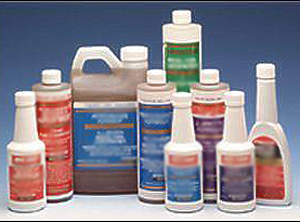 Because mostly what’s inside a can of fuel additive are chemicals to boost octane levels, you really don’t need it if you’re buying gasoline with the proper octane rating in the first place.
Because mostly what’s inside a can of fuel additive are chemicals to boost octane levels, you really don’t need it if you’re buying gasoline with the proper octane rating in the first place.
Fuel additives can sometimes cause problems instead when mixed with E10 gas. Many fuel additives claim to restore “E10” back to its pre-ethanol state, but according to many chemists it is not possible.
Check the ingredients in that container of fuel additive before you buy it. Using alcohol-based and strong solvent additives in fresh E10 gasoline is not recommended, since this may serve to raise ethanol content even higherwill only increase water absorption, parts corrosion, and may also raise ethanol content over the recommended 10% maximum.
Products that contain strong solvents, emulsifiers and water-absorbing agents should not be used with E10 gasoline either. Strong emulsifiers will not only force alcohol and water back into gasoline, they may also solidify engine lubricating oils and additives in gasoline. Clogging, gelling and gunk can build up in the engine.
Fuel additives can be helpful in a situation where too much water has gotten into a fuel tank due to a disconnected hose or other open entry in fuel lines. Usually those problems are repairable without too much difficulty, but in the meantime look for a lubricating fuel conditioner that delays “phase separation”. Or for a fuel stabilizer that claims to break down water molecules. If rusting of engine parts is a worry, look for a fuel additive that specializes in corrosion inhibiting.
6. BAD AND DEGRADED GAS – HOW IT HAPPENS
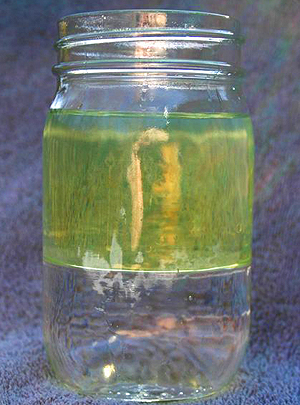
Alongside water condensation in fuel tanks, gasoline degrades naturally over time causing chemical breakdown of ingredients into a thicker more varnish-like substance. (Photo credit: M. Stevens)
Sometimes it’s already partially degraded when you buy it from the gas station. Unlike crude oil, gasoline is a highly refined product brewed to a certain chemical composition with very specific characteristics. One characteristic of gas is volatility, a term used to describe how easily and under what conditions the gas vaporizes so it can be efficiently burned in your car’s engine.
The most highly volatile components in gasoline also tend to evaporate over time. As they do, fuel’s volatility and ability to combust decreases. The less volatile the fuel, the less effectively it burns in your engine. Diminished engine performance and minor misfiring may result.
Oxidation of Fuel
Over time, hydrocarbons in the gas react with oxygen to produce new compounds that eventually change the chemical composition of the fuel. This leads to gum and varnish deposits in the fuel system. These deposits and impurities can clog up gas lines, filters, carburetor channels, and tiny fuel injector orifices.
Water Contamination
Condensation can form naturally inside your gas tank and lines from hot-and-cold temperature changes. Water contamination can be a problem at gas stations with light traffic due to a slightly different kind of heat cycling.
Underground storage tanks experience increases and decreases in temperature which can cause moisture to form and contaminate the fuel. When you fill up at such a station, you’re pumping in already-waterlogged gas. Such low-traffic stations may also have rust contaminating their storage tanks. Avoid these light traffic fuel stations whenever possible.
Water will cause hard starting and rough running until it’s purged out of the fuel system. It can also contribute to internal rusting of the gas lines and tank. Resultant scale and small particles can create a nightmare – in extreme cases replacement of the gas lines and tank are required.
Traditional wisdom says you can reduce the chances of water contamination by keeping the gas tank as close to full as possible, especially if the vehicle is going to be left idle for an extended period. However I always leave a little extra room for adding fresh gas the moment I take the car out again in the future.
Identifying bad gas
One way is to eyeball it. Oxidized fuel often turns darker over time and may even smell sour. You can check stored gasoline by pouring some into a clear glass container and comparing it side-by-side with known fresh gasoline. If your old sample looks noticeably darker than the fresh gas, you have strong evidence the gas has gone bad.

